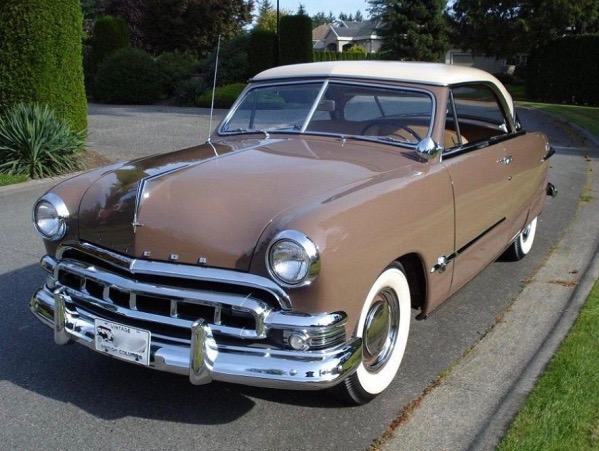However, by the late 1940s, the most advanced feature of the Traction Avant was its front-wheel drive, the rest of the car looking distinctly old-fashioned. Citroën and its Michelin owner were not about to rest on their laurels, setting out to create another technological sensation if they could.
The result was the DS series that entered production in 1955. Styling was by Flaminio Bertoni, who I wrote about here. The first of the series was the DS19, the 19 referring to its 1,911 cc motor. The first link in this paragraph mentions the DS19s major technical innovations: I will focus on its styling.
Here is a DS19 on display at a British auto show, not the 1955 Paris show where it made its debut. Note that this example has right-hand drive. The light colored car at the upper-right is a Rover.
Publicity photo of a 1956 DS19. There is no grille to speak of, radiator cooling air entering from the lower part of the front end, a feature common today, but rare then. DSs had a long 3,124 mm (123.0 in) wheelbase and short front and rear overhang.
Possibly the same car seen in the previous photo, this time apparently at an auto show. The windshield has tight curve radiuses, so I wonder how much distortion drivers and front-seat passengers experienced. Bertoni was a sculptural artist, so it is interesting how he treated the lower body, blending the hood with the sides. I suspect that the high front fenders were dictated by legal requirements in some countries regarding headlight height above the ground, and wonder if Bertoni might have preferred a different treatment.
Rear three-quarter view. Note the extremely short rear overhang, the rear wheels being placed nearly at the car's corners. An odd touch is the lights placed at the ends of those tube-like chromed rain gutter formers at the edges of the top. This seems like a weak copy of space ship and jet aircraft styling features found on many 1950s American cars.
The most striking interior feature was its steering wheel with only one attachment arm.
A publicity photo featuring pretty girls. The DS had a tall greenhouse with plenty of glass area. Making this visually even taller was the fact that the doors lacked window frames (though there was a slender B-pillar); see the top image for more detail. The thin roof, the flat window glass (a technological limitation of the time), the tall greenhouse, the fairly upright windshield and the flat C-pillars combine to create a comparatively rigid form that contrasts with the curvy lower body. Result: the Citroën DS19 is not a well-integrated design that seemed odd to me when first announced and still does not please me.















































